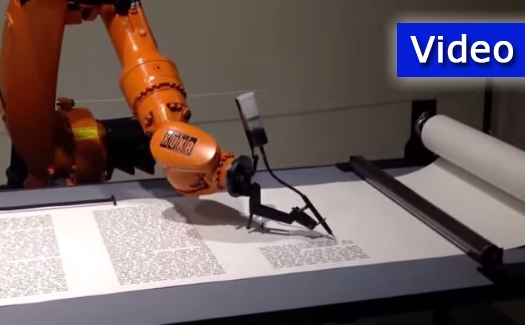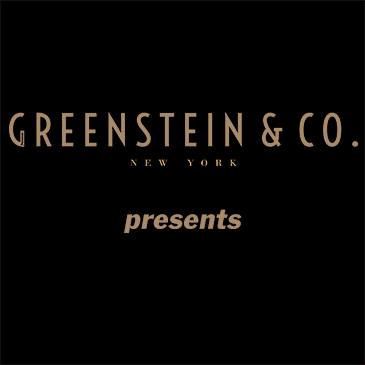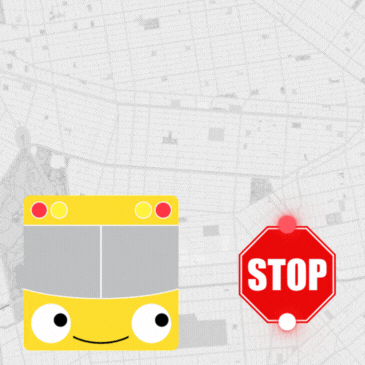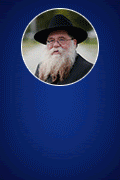
Video: Beware of Robot Scribe
A new technological development has raised concerns among the Orthodox-Jewish community around the world: A robotic scribe. Created by a German university, the robot can mimic the way a human ‘Sofer’ writes Hebrew letters on parchment, raising the possibility of authentic-looking but non-Kosher Mezuzos and Tefilin being sold on the market by unscrupulous sellers.
















sw
chabad houses should put the word out about that too. I would only go to who I know personally.
Is there a way............
Is there a way for a computer to pick up if this was written by a machine or by hand. I am referring to the computer used to check for missing or extra letters in the sefer Torah.
Halacha
Besides the kneejerk reaction to anything new, what is the halachic problem with this machine? certainly whoever is watching it work can have all the right machshavos. ( and better, no possibility of not being Leshma)
Milhouse
Are you nuts? What difference does it make what a person *watching it work* is thinking? He is not the one writing it! The machine is writing, and not only does it have no thoughts at all, it is not a male Jew over bar mitzvah, and anything it writes is automatically possul even if it *could* have thoughts.
A sofer
Actually, the human eye would be best to detect this kind of a thing.
if a Torah is too perfect – its not handwritten!
To 5:
True, but they can set it up to make variations and it won’t look the se then! You just gotta but from people you trust
shmuel 1600
put a yamulka on the robot he then becomes kosher
uziyohu brown
the sofer at #4 is correct. The letters will be exactly the same the whole way through and easy for a trained eye to detect but it is still possible to flood the market with thousands of mezuzas and maybe hundreds of tfillin and sifrei torah to the untrained eye rachmona litzlan u.brown sofer stam
The shpy
This sounds like something out of the shpy
levi r; attn #3
it must me written by a human being L’SHMAH
clue
At least in this video the parchment is perfectly white… Regular parchment have different shades..
shlomie
in the terms of the gemarah “masseh kof” “the work of a monkey”, as brought down regards to shcitah by a goy all the more so when it comes to sta”m which have to be written for the holiness of the sefer torah or mezuzos oe tefillin, n if not GEVALD!!
see toisfis yom tov in his explenation to the piskei haRosh in menachos.
its cool but all it has is the status of a chumush, see rambam.
Ich bin a Sofer
I have checked mezuzas where the same splotch of ink was in the same spot on a stack of mezuzas from Israel for sale in Miami. It was a new socher, well it all goes into the garbage, not even shaimos..
This robot is a glorified printer. it is not even using klaf.
There are many things to be careful of, such as glue in batim etc.
Know your socher, not just the sofer
why?
Why would a German university be interested in writing Stam?
Milhouse
Because it’s a delicate task. As a robotics project, it’s fascinating.
are there any shitas the consider it kosher?
MO and Brisk consider machine matzos better than hand. The person turning on the machine has the kavanah and shoin.
Can a similar argument be made for machine safros? What is the difference from a halchik perspective?
Milhouse
No, there are no shitas that would consider this kosher.
Yisroel
Let’s not jump the gun on this one. There is actually a chance that technology like this is kosher. R’ Schacter at YU thinks that a printed sefer torah is kosher, if the printing process was initiated by a Jew. R’ Abadi in Lakewood has developed a silk screen torah writing process.
Look into the halacha. “Chodosh assur min hatorah” isn’t the way we should look at every new thing that comes our way. Maybe it’s not kosher, but let’s investigate it and let the Rabbis who are experts in this field decide.
Milhouse
What is your source that R Schachter permits printing?
R Abadi’s process is rejected by almost everyone, just like his bizarre opinions on kashrus, but in any case his whole claim for his process is that the sofer is actually doing the writing, which obviously does not apply to a robot.
#12
masseh kof is less then a goy
shechita of a kof nevaila according to everyone
but their is an opinion that shechita of a goy is kosher (lmaase shechita of a goy is nevaila)
Chaim
Mendy and the Golem issue #5. Shofar so Good.
wow
Amazing what next?
if thats what is being used in the vid it is one long piece of parchment
no good
but wow, credit to the one who came out with it and better still it is coming from Germany out of all places
Kosher for Robots
But a minyan of robots could probably be yotzei on kriah from it.
More Learned Than You
For all the geniuses saying assur, Rabbi Abadi is no slouch. Before you say it’s assur, you should understand the Gemarah’s it is based on. And while most poskim disagree with him (certainly for a Sefer Torah) many hold there is room to be lenient on Megillat Esther. Rabbi Abadi’s Sefer Torah is done – not by robot – but buy Sofer using a silk screen over klaf.
Don’t paskin unless you know.
MendyT
put it in the mikvah, if it still works after its OK
Interesting article on this topic from www.stamforum.com
Robotic STa”M and other issues pertaining to STa”M not written by a human sofer.
By Rabbi Eli Gutnick
http://www.stamforum.com
Recently there has been a big fuss in the media about a novelty invention, namely a Torah writing robot. The robot, which looks like a giant bionic arm, was developed for the Jewish Museum in Berlin, where it is on display actively “writing” Torah scrolls.
This concept has everyone asking if STa”M (Sifrei Torah, Tefillin or Mezuzos) written by a robot is kosher. The simple answer is that it is not. By all three of the STa”M commandments, the Torah specifically uses the word “Uchsavtem” and “Kisvu” – that one should write them – clearly dictating that one needs to write these scrolls by hand, the way one writes a hand written letter or document. Printing, or the use of device that can form text but not through the act of normal writing is simply a breach of this biblical instruction.
Furthermore, there is the “Lishmosh” aspect – that these scrolls must be written with the specific and holy intention that only a human sofer is capable of. Even if one argues that when turning on an electric device one can do so with intention, the fact is that the writing of G-d’s names needs verbal proclamation and mental intent that a name of G-d is being written. How can a machine do that?
Some years ago , another controversy erupted when a Rabbi in Lakewood ruled that is was kosher to print STa”M by using a method known as silk screening. His argument is that the ink is applied onto the screen buy hand, which is a physical, manual act done by a person, and therefore it should be considered a form of handwriting. Furthermore, when one applies the ink he can do so “lishmosh , with all the correct intentions. No rabbi of note agrees with him, and this method is today considered largely fraudulent and prohibited.
Other halchically dubious techniques include “ksav al gabei ksav” and “the half printed, half written” method. In both, writing is printed on parchment and finished by hand. Ksav al gabei ksav means that STa”M item is printed and the sofer writes over it. This is much easier and quicker than writing from scratch. The halachic loophole is that only the second, upper layer counts, since it was written on top, and therefore the scroll is considered handwritten and not printed. (This method could only be applied Torah scrolls – where the letters do not have to be written in order (kesidran).
Yet the “half printed half written” technique can be argued to be acceptable for all STa”M. In this scam, a scroll is printed with incomplete letters. The sofer then completes the letters – in order and lishmah (with intention). It takes less than half the amount of time and far less skill to produce such products. This was the modus operandi of the recently publicized forger’s ring from Ashkelon in Israel that were caught by the Israeli Rabbanut Police. (They were subsequently released after arguing that their method was not against halacha.)
This leads to the other concern over the robotic scribe – that it may be used for fraud. This means to say that unscrupulous vendors of STa”M may use it to replicate properly written items and sell it to unsuspecting consumers.
Frankly, I do not see this as being a problem. If one is looking to fraudulently produce STa”M, there are cheaper and easier ways than investing in the substantial cost of developing, building, or buying a robot. A simple printing press is able to produce high quality STa”M on parchment, and the en product will not look inferior to that which is written by a robotic device. There is no advantage to using this device from a practical or monetary perspective.
Modern technology has also brought with it devices and gadgets which are permissible to use in STa”M production. These include electric or foot pumps that allow regular flow of ink to a quill (so time is not wasted dipping the quill manually into ink) and light tables that allow a sofer to trace from a stencil under the parchment. These devices are generally permitted because the end product is still 100% hand written and these devices merely assist the sofer.
In conclusion, if there would be a halachic grounds allowing the use of a robot, there would be a much grater concern. People may be tempted to use and sell this type of device on the basis of a minority opinion such as the abovementioned Rabbi who permits silk screening in Lakewood. It could then possibly infiltrate the mass market. However as it stands, the robotic scribe in Berlin remains a one off novelty invention and poses no threat to the kosher STa”M industry.